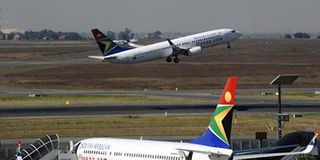Africa's once leading airline, South African Airways on brink of collapse

A South African Airways (SAA) flight takes off from O. R. Tambo International airport in Johannesburg. Photo | FILE
What you need to know:
Unions oppose the selling of the loss-making firm or any retrenchment.
But Finance Minister Tito Mboweni recently saying the inefficient state-owned enterprise would likely never make money
- Apart from being unable to make a profit SAA has had to deal with a strike by staff over an eight per cent pay rise demand this past week.
South African Airways, once the continent’s leading airline, is on the brink of collapse.
The firm is insolvent and the government is looking for a buyer. It has received state bailouts of almost $4 billion but still has an outstanding debt of $613 million.
COSTLY CONTRACTS
Apart from being unable to make a profit – with Finance Minister Tito Mboweni recently saying the inefficient state-owned enterprise would likely never make money – SAA has had to deal with a strike by staff over an eight per cent pay rise demand this past week.
The strike came as the airline was scrabbling to meet its November salary obligations. The airline’s position is so weak that it is struggling to secure funding to cover day-to-day operations.
Its woes stem from a combination of poor and profligate management, misuse of funds and corruption.
For years, political contacts were more important to obtaining placement in SAA’s senior management or on its board than being able to do the demanding job of running a national airline.
The strike ended on Friday, with the management agreeing to a staggered 5.9 per cent salary increase – and with the unions undertaking to find the other 2.1 per cent they had been demanding by cutting or renegotiating costly contracts.
$23 MILLION
The unions said their action saved jobs and the airline itself.
Not only was it unclear, however, that SAA was “in the clear” following the settlement, but the tasks taken on by the unions to save SAA money and still retain jobs appeared mutually exclusive since one of the airline’s major costs comes from excess staff complement.
The initial impact of the strike was the cancellation of almost all flights for two days. Its direct costs amounted to another $23 million.
Despite their victory, the workers may find the airline’s parlous finances are beyond their powers.
The airline was about to launch long-delayed restructuring plans, including cutting about 1,000 jobs, something the unions vehemently oppose.
SAA has, meanwhile, advised its workers to make arrangements with their banks because it cannot guarantee their November pay.
11,000 JOBS
Spokesman Tlali Tlali said: “The airline has yet to finalise the process of raising about $133.3 million...to fund its day-to-day operations. We remain optimistic that the issue will be resolved.”
Even with drastic staff cut-backs – which unions have vowed not to allow – and route cuts, liquidation of the national carrier is seen as inevitable.
Trade union Solidarity has already served court papers on SAA and Public Enterprises Minister Pravin Gordhan, asking the High Court to put the airline into business rescue rather than allowing it to collapse.
A court-appointed practitioner would have comprehensive powers to rescue SAA, overriding its ineffectual management.
Solidarity’s head Dirk Hermann said while his union and its members are aware of the crisis, the company is heading for liquidation without radical intervention, “with enormous fallout for employees, the economy and taxpayers”.
Some 11,000 jobs are at stake in an economy with formal unemployment at more than 29 per cent and 10.5 million jobless people.
TAXPAYERS' PAIN
But there are still irreducible problems, not least that the underlying business model does not work – too many flights with too few paying customers on too many routes and with too many staff.
The strike outcome means SAA’s most effective cost-cutting option, retrenchment of staff, is permanently off the table.
This limits what the management or a business rescue expert might achieve.
Legal experts say it is highly likely that the court will refuse to allow business rescue and opt to liquidate the airline as it has been technically insolvent since 2013 when its liabilities exceeded assets by almost $50 million.
Even if the airline is liquidated, the pain will not be over for taxpayers since its outstanding debts and underwritten loans would be called in. The country’s fiscus cannot afford to cover SAA’s debts or give it more bailouts.
DEBT BURDEN
Despite a government bailout of $800 million in 2014, the airline was $320 million in the red. And the situation has grown worse every year.
The last SAA financial reports issued were for the year to March 2017, when liabilities exceeded assets by $1.2 billion.
The auditor-general said SAA could not be regarded as a going concern, given six consecutive years of losses and a huge debt burden.
It therefore came as no surprise when the government said it is looking for buyers.
“I am pleased to learn that there are conversations involving SAA and potential equity partners,” Mboweni told lawmakers.
FAMILY JEWELS
Unfortunately, it is not clear if there is any serious buyer in the horizon. Even if the government finds one, it is certain the unions which called the strike would take similar vigorous action against “selling off our family jewels”.
Erasmus writes from Pretoria. [email protected]





